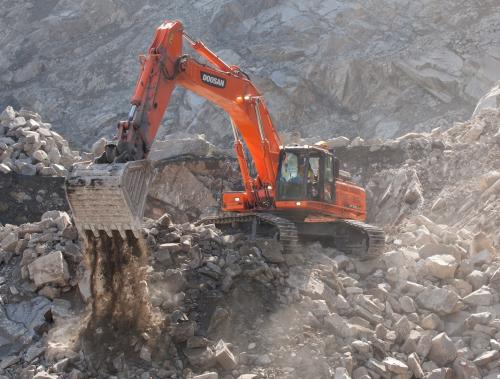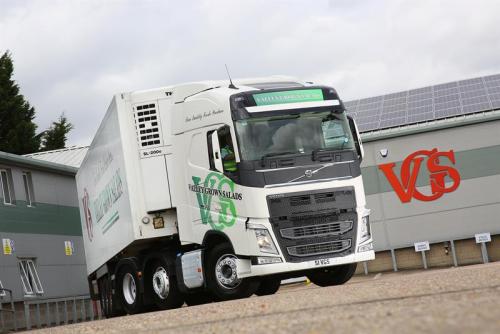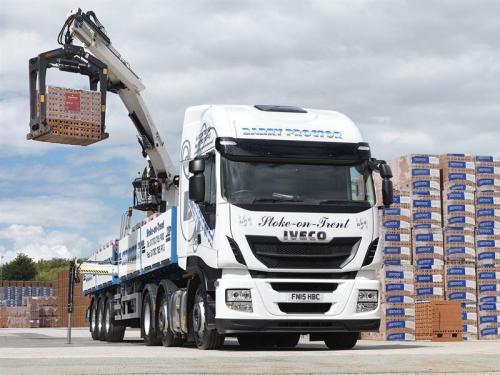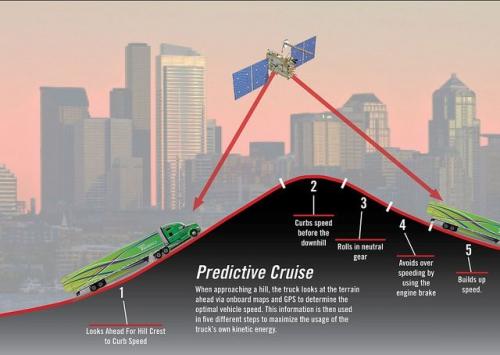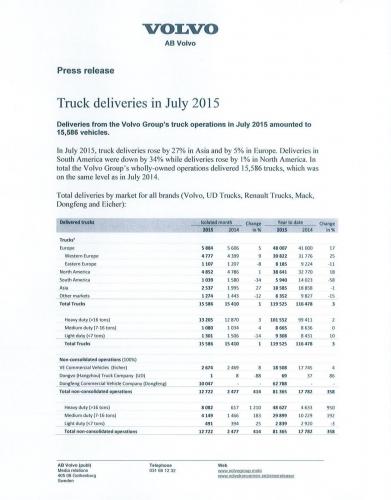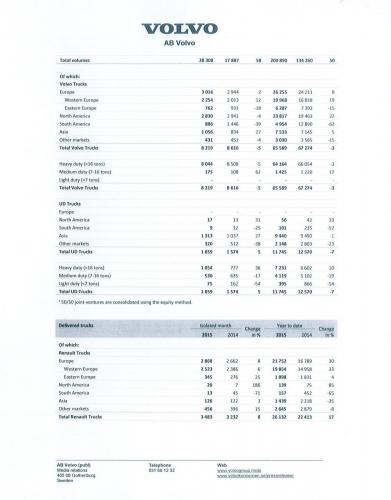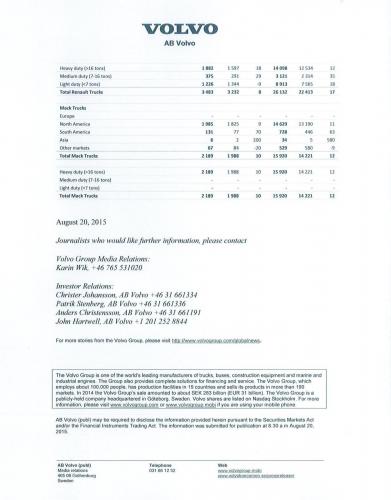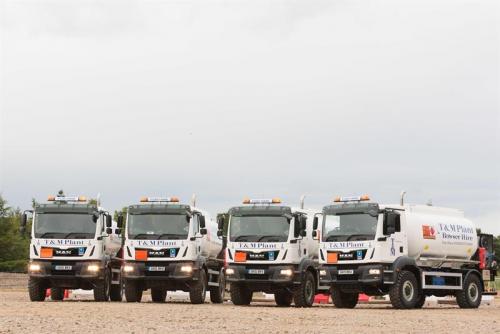
kscarbel2
Moderator-
Posts
18,541 -
Joined
-
Days Won
112
Content Type
Profiles
Forums
Gallery
Events
Blogs
BMT Wiki
Collections
Store
Everything posted by kscarbel2
-
Volvo Demonstrates Adaptive Loading System (6x2 lift axle)
kscarbel2 posted a topic in Trucking News
Transport Topics / August 21, 2015 Volvo Trucks rolled out a drivetrain system that management hopes will give the company a larger presence among liquid and bulk haulers, regional distribution carriers and trucking companies that often deal with diminishing loads or empty backhauls. The adaptive loading system, built around an electronically controlled suspension, switches automatically between 6x2 and 4x2 power configurations with the use of a forward tractor tandem axle that can be lifted off the ground. Company managers told reporters and editors here on Aug. 20 that when a trailer is mostly full, the lift axle places the wheels on the ground so they can bear weight and roll freely like trailer wheels. In contrast, when a trailer is mostly or completely empty and the tractor axle is not needed, up it goes and the 18-wheeler becomes a more efficient (albeit less lyrical) 14-wheeler. “Volvo has long been known as a highway tractor manufacturer in the longhaul segment,” said Wade Long, Volvo director of product marketing. “But this will help us on regional growth. It’s a second opportunity for growth.” The lift axle is made by Link Manufacturing Ltd. of Sioux Center, Iowa, and the drive axle is from Meritor Inc. Volvo announced the system at the Mid-America Trucking Show in March, having started limited production in 2014. Full production starts in January, though, so the company is starting a major offensive to garner attention. During briefings in Salt Lake City and here, and ride-and-drive demonstrations on the highways in between, Volvo managers said the new system is not the same as a traditional 6x2 configuration where both axles are always on the ground — a drive axle and a tag axle. (In the more commonplace 6x4 configuration, both tractor tandem axles receive power from the engine.) Traditional 6x2s have often been criticized for their lack of traction, but Volvo has addressed the problem with “dynamic weight transfer,” said Chris Stadler, product marketing manager for regional haul. Beyond just axle up or down, Stadler says Volvo software takes input from sensors and balances weight on the tandem tractor axles as needed. For a fully loaded trailer the weight is balanced evenly between the two. For a lighter load the drive axle takes most but not all of the weight. Eventually when the load is light enough the axle lifts. Extra weight can also be shifted to the drive axle when there is a need for more traction. The company brought in customers, fleet executives, who said the axle-up configuration improves safety because the tractor’s wheel becomes longer and weight is split between the drive and steer axles, leading to better steering and handling. “Everything has been positive with this,” said Joel Morrow, vice president and part owner of his family’s Plover Transportation, a small truckload carrier in Bellevue, Ohio. “We’ve improved fuel efficiency, and they have better handling. The trucks have helped with our driver recruitment and retention. We have drivers asking to get into trucks with lift axles,” Morrow said. Clay Handy, president of Handy Truck Line in Paul, Idaho, said he had already been thinking about converting to regular 6x2 tractors, so when Volvo contacted him about participating in a prototype test, “We jumped on it immediately.” Handy said he might switch over 100% of his 120 trucks to adaptive loading. J.W. Ray said he enjoys driving an adaptive loading truck for Idaho Milk Transport of Burley, Idaho. September marks his 40th anniversary as a driver, and during that time he has racked up 6 million miles. “This is the most expensive toy I’ve ever gotten to play with,” the smiling Ray said. -
The Chaos Continues - Coming soon to a neighborhood near you
kscarbel2 replied to kscarbel2's topic in Odds and Ends
Fiction: ‘A black man is killed in the US every 28 hours by police’ The figure comes from this unofficial and unashamedly partisan report by a black nationalist organisation, the Malcolm X Grassroots Movement. The data is a collection well-known cases usually reported by local media. The group claims 313 black people were killed in 2012 by “someone employed or protected by the US government”. But not all the killers are police officers, or even government employees. They include shop workers, private security guards and members of the public. In one case, a 13-year-old girl was shot dead by two school friends who found a gun in an off-duty policeman’s car. You would have to look carefully at the circumstances of every killing before deciding that every one was an example of police racism. How about this almost equally widely discussed stat which Rudy Giuliani, the former mayor of New York, produced in a heated post-Ferguson TV debate: “Ninety-three per cent of blacks in America are killed by other blacks.” His point was that black-on-black violence claims more lives than police killings, while attracting less publicity. He’s right about the 93 per cent, which comes from Bureau of Justice Statistics research into homicides from 1980 to 2008. What he failed to mention is that the vast majority of white victims were also killed by whites in the same period – 84 per cent. There’s a simple explanation for this. Most murders involve the victim’s family and friends, who are more likely to be from the same race. Reference: http://blogs.channel4.com/factcheck/factcheck-black-americans-killed-police/19423 -
The Chaos Continues - Coming soon to a neighborhood near you
kscarbel2 replied to kscarbel2's topic in Odds and Ends
Illinois mother and former U.S. Navy officer Peggy Hubbard says Black Lives Matter protesters should focus less on police brutality and more on black on black crime. She said that instead of protesting black on black crime, Black Lives Matters protesters instead took to the streets to march for an 18-year-old black man who was shot. 'Last night, who do you think they protested for? The thug, the criminal, because they’re howling, "police brutality." Are you kidding me? Police brutality? How about black brutality,' said Hubbard. 'A little girl is dead. You say black lives matter? Her life mattered. Her dreams mattered. Her future mattered. Her promises mattered. It mattered,' she added. Hubbard said she has a son behind bars who she turned into police. 'I turned him in. Yes I did because I’m a strong black woman. I am a black mother. I told my children that if you (mess) up, if you go to jail, I am not getting you out. You will stay there. You will do the time. I am not coming to visit you. I ain’t sending you magazines. I’m not doing anything for you because I did everything I could for you out here and yet you chose to go in there.' -
Off-Duty US military take the fight to the terrorist
kscarbel2 replied to kscarbel2's topic in Odds and Ends
The Financial Times / August 23, 2015 The ease with which the terror suspect in the failed train attack moved around Europe has put the spotlight on the passport-free Schengen Area. Calls for tighter border security within Europe are expected to increase after it emerged that the gunman overpowered by passengers in France on Friday was known to anti-terror authorities in France, Belgium and Spain. Charles Michel, Belgium’s prime minister, called for urgent talks with France, Germany and the Netherlands on increasing security on cross-border trains. However [despite today's rampant terrorism situation], the European Commission said the Schengen treaty on freedom of movement was “non-negotiable” and there were no plans to change it. But it said increased security controls could be compatible with Schengen “if they do not have an effect equivalent to border checks”. The train originated in the Netherlands, passing Belgium before entering France — three of the 26 Schengen countries where people travel without the need for passports and security checks (a terrorist's paradise). Passport and luggage checks are, however, carried out on Eurostar services that run to Britain, which is outside the Schengen Area. French authorities said Ayoub el-Khazzani, 26, a Moroccan, had lived in the southern Spanish city of Algeciras, frequenting a mosque that had been under surveillance. Mr el-Khazzani left Spain for France in 2014, travelled to Syria and then back to France, a Spanish counter-terrorism source said on Saturday. He had also lived in Belgium and may have had connections to a group involved in a suspected Islamist shooting in Belgium in January, Le Voix du Nord, a French newspaper, reported. The suspect spent seven years living in Spain, where authorities were apparently aware of his extremist leanings and where he had been arrested repeatedly for drug trafficking. According to reports in the Spanish press, his name was entered into the pan-European database of suspected Islamist radicals in 2012. Spanish antiterrorism officials passed on information about him to their French colleagues as soon as he left the country. “When we became aware that he had left to live in France, we gave all the information to the country´s security authorities and made sure they knew he was a dangerous subject,” an unnamed Spanish official told the El Mundo daily. “France had him under control until [he] decided to leave for Syria. From then on, neither they nor we had any news about him.” Mr el-Khazzani reportedly lived in Madrid and in Algeciras, a port hub for ferry traffic to Morocco. He arrived in the country in 2007 and left in 2014. Spanish law enforcement told their French counterparts in March 2014 that Mr el-Khazzani had a “relationship with radical Islam”, the Spanish El País newspaper reported. Mr el-Khazzani was tackled by three Americans and a Briton as he prepared to fire his AK-47 assault rifle on the Thalys high-speed train from Amsterdam to Paris via Brussels. The train crew have been accused of barricading themselves in a staff room and abandoning passengers to their fate. Jean-Hugues Anglade, a French actor who activated the train alarm, told the magazine Paris-Match that passengers thought they were going to die “because we were prisoners of this train”. Train crew unlocked the staff room then shut themselves inside and ignored passengers banging on the door, calling for them to open up, he said. “We heard passengers shouting in English, ‘He’s firing, he’s firing. He has a Kalashnikov’.” Mr Anglade said he saw train personnel running down the corridor to take refuge in their car. “We were incredibly lucky to have American soldiers with us. I pay homage to their heroic courage and thank them. Without them, we all would be dead.” Chris Norman, a British IT consultant, helped the Americans overpower the gunman and said he thought he was “probably going to die anyway”. Mr Norman, 62, said he knew he was facing a terror attack “the moment that I stood up and saw a guy with an AK-47”. After giving evidence to police in Arras, France, he said: “My thought was ‘OK I am probably going to die anyway so let’s go. I would rather die being active, trying to get him down than simply sit in the corner and be shot.” -
Off-Duty US military take the fight to the terrorist
kscarbel2 replied to kscarbel2's topic in Odds and Ends
Humorous indeed. ---------------------------------------------------- Morocco-born gunman Ayoub El Khazzani, 26, laughed at accusations that he was not trying to carry out a terror attack, and claimed that he had found the arsenal of weapons used by chance under a bush in a park. ‘He can’t understand why this affair has generated such publicity,’ his lawyer, Sophie David. ‘He says he only wanted to rob the passengers on the train and nothing else. Security in the EU is a convoluted joke. Khazzani had already been on government officials' radars in four European countries before he carried out Friday evening's terror attack. He had been deemed a terrorist threat following the Charlie Hebdo massacre in Paris - and had fought with ISIS in Syria earlier this year. How Khazzani was able to move freely around Europe, despite being widely known as 'potentially dangerous'? -
Virginians pay inflated power bills to fund the political donations of Dominion Resources, the power company that owing to its political connections has a monopoly on over 60 percent of Virginia's electric market. ------------------------------------------------------------------------------------------------------------ The Associated Press / August 22, 2015 Virginia residents have been billed tens of thousands of dollars to pay for donations the state's most powerful electricity company has made to politically connected charities, according to company records obtained by The Associated Press. Recent Dominion Resources Inc. donations subsidized by customers include a $10,000 gift to a college that was solicited by a powerful state lawmaker who is also the school's paid fundraiser, and a $40,000 donation to a tort reform group that pushed for business-friendly legislation with the help of a longtime Dominion lobbyist, the records showed. Adding the cost of certain charitable contributions — though not lobbying expenses — to electricity consumers' monthly bills is legal under longstanding and little-noticed regulatory rulings. The practice is not unique to Virginia, though it's barred in some states. Dominion, the state's largest electricity utility, has passed well over $1 million dollars in donations onto consumers in recent years. The situation roils some current and past state officials. "Why should captive ratepayers, who have no option to get electricity from another company, be compelled to fund the charitable choices of a company?" said former Virginia Republican Attorney General Ken Cuccinelli. "Leave the ratepayers their money, and let them make their own charitable choices." Cuccinelli said donations to groups that employ lawmakers were "additionally dicey." Dominion is the digital age's answer to the tobacco and railroad industries that once ruled Virginia politics. The $40 billion energy conglomerate is the biggest corporate donor to state political campaigns and has some of the most well-connected lobbyists. Katharine Bond, director of public policy for Dominion, said the company is following well-established precedent by including some donations in the base rates, which make up the majority of customer's bills. And she said the company feels it "is important to support the communities in which we do business." Many analysts said Dominion's broad charitable giving is a large reason for its out-sized influence. "Dominion is the 800-pound gorilla," said state Democratic Sen. Creigh Deeds. "They contribute to charities, they make lots of friends ... It's just awfully hard to oppose them when they have that kind of support." The Virginia State Corporation Commission sets the rates regulated monopolies like Dominion charge after reviewing the companies' expenses, including some donations. Details about those expenses are largely private, but AP obtained specifics about some of Dominion's giving through public records requests with the attorney general's office. The company's shareholders fund donations made by its charitable foundation — $15 million in 2013. But its customers help pay for hundreds of contributions to civic, educational, and religious groups Dominion makes separate from its foundation. For 2011 and 2012, the SCC allowed Dominion to include $1.37 million before taxes in donations as part of the cost of service it charges customers, according to a commission spokesman. SCC staff recently filed testimony saying Dominion should not be able to pass on any of the $3.3 million in donations from 2013 and 2014. SCC staff said "many of the donations made by the company were to organizations that conduct political or lobbying efforts" and that Dominion had recorded charitable contributions inconsistently, including in accounts for "office supplies & expenses" and "employee pensions and benefits." Company spokesman David Botkins disputed the SCC staff testimony and said the company will file a detailed rebuttal later this month. The SCC's three commissioners will rule on the charitable contributions later this year. Dominion's political power was on full display earlier this year when the General Assembly passed, and Democratic Gov. Terry McAuliffe signed into law, a major revision of how Virginia regulates electric utilities. The measure suspends until 2022 biennial reviews of Dominion's base rates. The company said it provides a "needed transition period" while Virginia sorts out how to deal with new federal pollution rules. Critics, including Democratic Attorney General Mark Herring, said the legislation could let Dominion charge excessive rates unchallenged. An expert witness for Herring told the SCC that Dominion's rates are currently too high by about $630,000 a day, while SCC staff said the figure was about $860,000 a day. Dominion disputes both figures. "Really, I think the bill was ludicrous," said Clint Miller, a former Republican lawmaker and SCC commissioner. "But because of (Dominion's) political clout they got it through." Del. Terry Kilgore, the Republican head of the powerful House Commerce and Labor Committee, helped usher the bill through the House of Delegates. Customers paid $4,000 of a $10,000 gift Dominion gave to the Appalachian College of Pharmacy in 2012. Kilgore is a fundraiser for the school with $126,000 annual salary in recent years, tax records show. Kilgore said Dominion's donation aimed to help the community, not curry his favor. "Dominion is a giving company," said Kilgore, whose largest campaign contributor is Dominion. "They give a lot." The Peninsula Council on Workforce Development, where Democratic Del. Matthew James is the CEO, gets regular Dominion donations. Dominion is currently seeking approval to pass the cost of a $7,500 donation to the group to its customers. The money paid for a workforce development seminar by The Walt Disney Co. Earlier this year, James sponsored legislation at Dominion's request that mirrored part of the larger rate review freeze legislation. Dominion is also James' biggest campaign donor. James said Dominion was one of several corporate members of his group and the donations don't affect his role as a delegate. "That's my day job. And it has nothing to do with the General Assembly," James said. Bond, the Dominion executive, said political connections don't factor into the company's giving. "Who is on the payroll is not part of the equation when we are evaluating where grant money goes," she said. A diverse mix of nonprofits and trade groups that received customer-subsidized donations, including the Virginia chapter of the NAACP and the Virginia Chamber of Commerce, also testified in support of Dominion's rate-freeze bill. Dominion's $25,000 donation accounted for more than 10 percent of the Virginia Hispanic Chamber of Commerce's income in 2013, tax records show. Michel Zajur, the chamber's CEO, said his group supported the bill on its merits. State regulators don't let Dominion bill consumers for lobbying costs, but some customer-subsidized donations went to a group that shares lobbying ties with the company. In 2012, Dominion gave $40,000 to the Virginia Alliance for Tort Reform, a short-lived group that lobbied for business-friendly legal reform. The SCC let Dominion pass $16,000 of that onto customers. One Alliance lobbyist, Bill Thomas, is a longtime Dominion lobbyist. Neither Thomas nor W. Heywood Fralin, a businessman who organized the Alliance, returned calls seeking comment. State regulators will decide later this year what 2013 and 2014 Dominion contributions can be passed to customers. After that, thanks to the rate freeze legislation, the company will not have to justify its ratepayer-subsidized charitable spending to regulators for the next seven years.
-
Because of totally incompetent security by SNCF French Railways, a terrorist was able to board a Paris-bound train with a Kalashnikov, 9 full magazines of ammunition (almost 300 rounds) and a hand gun. In a true act of heroism, two off-duty U.S. servicemen, Spencer Stone and Alek Skarlatos, members of the Air Force and Oregon National Guard respectively, subdued the terrorist and saved the lives of all the passengers on the train. Spencer Stone suffered stab wounds from a knife and is in critical condition. (Initial news reports stated the servicemen were two U.S. Marines) http://www.dailymail.co.uk/news/article-3206426/U-S-Marines-armed-gunman-onboard-high-speed-train-Amsterdam-Paris.html http://www.dailymail.co.uk/news/article-3206504/Unarmed-Marine-critical-condition-Kalashnikov-wielding-suspected-terrorist-board-high-speed-train-Amsterdam-Paris.html
-
Alabama woman sentenced to death for children’s torture, murder The New York Daily News / August 20, 2015 An Alabama woman who helped barbarically torture and murder her common-law-husband's two small children has been sentenced to death. Heather Leavell-Keaton was sentenced to die by lethal injection Thursday, six months after the children's father, John DeBlase, was handed the same sentence. Keaton was found guilty of poisoning the children, Natalie, 5, and Chase, 3, with anti-freeze in their meals but it was the choking that ultimately killed them, the court heard. After enduring months of being burned with cigarettes and hot candle wax, the oldest child was duct-taped and stuffed inside of a suitcase for 12 hours in March 2010. When she was finally released she was choked and her body dumped in a garbage bag in woods near Citronelle, Alabama. Three months later, after detectives say Natalie's brother started crying and asking about her in public, creating a "liability," Chase was taped to a broom handle and left in the corner of the couple's bedroom overnight. Eventually he too was choked to death and his body tossed in woods outside Vancleave, Mississippi in Dec. 2010. Their skeletal remains were found a few days later. 'We believe that Heather Keaton...is a domineering, manipulative, deceitful and morally unhinged woman,' Mobile District Attorney Ashley Rich said prior to the ruling. 'Her actions are worthy of the death penalty.' .
-
Transport Brazil / August 12, 2015 At the request of agricultural haulers in the Brazilian state of Parana engaged in grain transport, Scania has engineered an 8x2 tractor configuration that, combined with the use of a three-axle trailer, allows a legal gross combination weight of 54.5 metric tons (120,152 lb). Driven by the needs of grain carriers like G10 Transport (http://www.g10transportes.com.br/), Scania created an 8x2 configuration featuring a steered and liftable wide-track pusher axle with single mounted tires, and liftable narrow track tag axle with dual mounted tires. Based on the 13-liter 440 horsepower model R440, Standard, Highline and Streamline cab configurations are available. The 8x2 configuration provides the capabilities of a 6x4 at a lower purchase cost, and with reduced tire wear. To ensure a high degree of maneuverability, Scania chose a 3,900mm wheelbase. The truck's two 330 liter fuel tanks are located behind the cab.
-
Scania Press Release / August 20, 2015 Doosan’s new 50 metric ton DX530LC-5 excavator is undergoing endurance trials in the mountains of South Korea’s South Chungcheong province, and Scania is playing a key role. When you’re in the quarrying business, you need heavy machinery that you can depend on. With environmental regulations around the world rapidly becoming tougher, you also need equipment that meets the latest emissions standards. The process of developing just such equipment is now underway in South Korea, where industrial and construction equipment maker Doosan is working with Scania and local customer Bochang Industries. In the mountains surrounding the South Korean coastal city of Boryeong-si, the three companies are testing the DX530LC-5, a powerful large excavator featuring a 13-liter Scania DC13 Tier 4 engine. The excavator aims to marry functional engine design and low emissions output to produce a piece of heavy machinery capable of turning rocks into gravel. Featuring XPI (extra-high pressure injection - 2400 bar) common rail fuel injection and Selective Catalytic Reduction (SCR), Scania's 13-liter DC13 engine is able to meet Stage IV emissions without the use of a Diesel Particulate Filter (DPF), so there's no reduction in operational productivity due to regeneration requirements. Testing ground for Scania Doosan cooperation Bochang Industries excavates rock that is then crushed into gravel for construction use. It has excavated a long string of hillsides around Boryeong since 1992. Bochang’s quarry has been a testing ground for Doosan products since 2004. With Doosan and Scania signing an agreement in 2014 to produce Tier 4 final engines for Doosan’s new series of 40 to 50 metric ton excavators, the focus of activities in the quarry has been on the heavyweight DX530LC-5. The testing process involves a prototype being put to work, and Scania and Doosan working together with Bochang to rectify any unforeseen problems. So far, the prototype has clocked up 500 hours of operating time. Scania’s Engineering Project Director in Korea, Ian Hooper, says, the new excavator incorporates significantly higher levels of technology to control emission levels. Quiet and responsive Lee Young Woo, an excavator driver with 25 years’ experience, has been testing the DX530LC-5 and says it is quiet and responsive. “The dynamic characteristics are better than other machines,” he says. “The noise level is lower and the engine response is better. With more engine space, it’s easy to maintain and the ergonomics of the pedals are more functional. With increased power, Woo easily shifts around 250,000 metric tons daily, with the 380 horsepower Scania engine returning to its 1,800 rpm in less than a second under load. “This machine lets me utilize all its engine power,” says Woo. Long relationship with Scania Having a Scania engine in the quarry is no new experience for Bochang Industries. The company uses a wide array of Scania-powered equipment in its day-to-day operation. Its relationship with Scania began in 1995 when Bochang’s manager, Juhun Kwon, began operating Scania vocational trucks. He says the experience highlighted the performance and reliability of Scania engines. “Excellent fuel consumption, durability, and reliability of the engine are the key factors in our choosing Scania engines,” Kwon says. “Importantly, we have access to many service dealers, including Doosan and Scania, so it’s easy to get parts.” Related reading - http://www.doosanequipment.eu/assets/imported/transformations/content/product-details/%7Blanguage%7D_Brochure/6DE2510E690C48BB85335B42D25A9B8B/en-dx420lc-5-dx490lc-5-dx530lc-5-brochure.pdf .
-
Scania Press Release / August 20, 2015 With 5.3 million kilometers (3,293,267 miles) on the clock, Peter Royter and his impressive 1989-year model Scania model 113M 6x4 tractor have both gracefully retired after a full life on the road. Though Royter is now back at his home in Buff Point, 110 kilometres north of Sydney, his veteran Scania tractor has been awarded a prominent place at National Road Transport Hall of Fame in Alice Springs. Peter Royter acquired his first Scania, a model LB80, in the late 1970s, not long after the Swedish truckmaker first entered the Australian market. He has since owned one 141 and two 142 models. Why only Scania? “Because I love Scania, ever since they entered Australia it’s been the best truck.” In 1992, Royter purchased the 3-year old 113M, which after 700,000 km was in a dilapidated state. He invested a fair amount of money and with the help of the Scania dealer in Coffs Harbour, K and J Trucks, restored the truck to a better than mint condition. “I knew that this was going to be my last truck before retirement and therefore worth preserving.” Over the past 23 years, until retirement at the age of 67 three months ago, Royter has made countless journeys across Australia, transporting palm trees to clients in Melbourne and Sydney. And although he now has abandoned the road, he and his wife Sandra continue to operate their plant wholesale business. “I’m healthy and want to spend more time with my wife and the rest of the wonderful family.” Four years ago, he was inducted into the Hall of Fame in recognition of his long driving career since the age of 17. “They expressed an interest in my truck and now it’s in Alice Springs. The Hall of Fame felt that it was so spectacular that it has earned a place not in the museum but a more publicly visible place. It’s a glamorous truck with a lot of accessories.” Royter doesn’t regret having donated his marvel to the Hall of Fame. “It was wise to donate the truck to posterity; it will be there forever. In 20 years’ time, people will see it and think, goodness me what a truck. They simply don’t make trucks like they used to.” Related photographs: http://newsroom.scania.com/en-group/files/2015/08/IMG_0506-this.jpg http://newsroom.scania.com/en-group/files/2015/08/IMG_0480_done-this.jpg
-
The decline of American morals, ethics and values / Today’s Navy
kscarbel2 replied to kscarbel2's topic in Odds and Ends
Your Tax Dollars at Work. Where is the oversight? Who's watching our employees in Washington? Hundreds of U.S. government employees — including some with sensitive jobs in the White House, Congress and law enforcement agencies — used Internet connections in their federal offices to access and pay membership fees to the cheating website Ashley Madison, The Associated Press has learned. http://news.yahoo.com/evidence-infidelities-spreads-online-wake-hack-144026220.html# -
Transport Engineer / August 20, 2015 Essex-based Valley Grown Salads has taken delivery of three Volvo FH-500 6x2 tractor units to deliver its produce around the South East. Supplied by Volvo Truck and Bus Centre London, Enfield, the tractors are on a five-year contract hire, including a Volvo Gold R&M contract. Valley's transport manager Joe Russo says the vehicles look "fantastic and purposeful", and are proving popular with the drivers. Russo's father and managing partner Jimmy Russo adds: "We're all about fresh produce so our trucks have to look good and clean and be reliable. Volvo absolutely ticks these boxes and our drivers are happy, which means a lot to us as a family-owned business." He adds: "The interior of these new trucks is beautiful and of an exceptionally high standard, which really improves the working environment." .
-
Transport Engineer / August 20, 2015 Haulage firm Barry Proctor Services has taken delivery of two Stralis Hi-Way 6x2 twin-steer tractors (steerable pusher axle), after two other Stralis trucks in the fleet delivered good fuel performance compared to other models. Supplied by dealer Sherwood Truck & Van, the Stoke-on-Trent operator's latest additions have 11-litre engines, producing 480bhp between 1,500 and 1,900 rpm, and up to 2,250 Nm of torque between 950 and 1,500 rpm. The engines use Iveco's HI-SCR technology to meet Euro 6 emission limits without the need for EGR (exhaust gas recirculation). The vehicles feature the manufacturer's Efficiency Package, which includes: an Eco-Roll function to monitor the road angle and shift into neutral on downhill stretches; a new engine oil management system; and OW-20 low-viscosity oil to boost engine efficiency and stretch oil drain intervals. The tractors are replacement for existing vehicles, one of which was a Stralis – and the driver requested another, based on handling and comfort. Managing director Barry Proctor says: "When we looked at the whole life cost benefits of running the Stralis – particularly with the new efficiency features added and the driver's personal recommendation – it made the decision very straightforward." Proctor has specified a forward-facing camera and RAM Tracking device to meet its insurance guidelines and enable driver monitoring. A microwave oven has also been installed on board, for added driver comfort. .
-
After market harness into mack
kscarbel2 replied to 68-f-model's topic in Electrical, Electronics and Lighting
I have purchased the Painless Performance headlamp relay kits over the years from JEGS for exactly the reason you mention. I wish more people were aware. -
Diesel News Australia / August 21, 2015 When the world thinks about Australia and trucks, this is the image which comes to mind for many. The big trucks with GCMs way beyond anything on a public road elsewhere are a symbol of the Aussie trucking industry’s can-do spirit in the face of the conditions and tasks we face. Big bangers pulling lots of trailers defines our country. One of the knock on effects of this obsession with big trucks is the fact we have so many truck manufacturers choosing to compete in our market. We have many more brands than most of the world, and they are fighting for market share in, what is, a relatively small truck market, nearly 30,000 trucks a year, but way below the number achieved in the US, Europe and Japan. The thing is, every chief executive or board chairman at a major truck manufacturer feels the need to have a large framed photo in their boardroom of one of their prime movers hauling multiple trailers in an outback location, with plenty of dust kicked up off the dirt road.
-
Heavy Duty Trucking / August 20, 2015 DAF Predictive Cruise Control is now in production for new Kenworth T680s and T880s with Paccar [DAF] MX-13 engines. Introduced by DAF in September 2014 at the IAA commercial vehicle show, Predictive Cruise Control combines cruise control with GPS to deliver improved fuel economy for the situation and is available as a factory-installed option. It is available with Eaton UltraShift and Eaton Fuller Advantage automated manual transmissions. “By anticipating the terrain ahead, DAF Predictive Cruise Control ensures that the Paccar MX-13 engine and the transmission are in the most efficient operating mode to increase fuel economy,” said Kevin Baney, Kenworth chief engineer. In addition to Predictive Cruise Control, Kenworth is also offering the Driver Performance Assistant, Driver Shift Aid and Driver Reward systems all designed to get the most from fuel economy. The Driver Shortage Assistant is now standard on T680s and T880s with an MX-13 engine. For information click here. .
-
The R-487P was factory built as a single axle rigid. However now it has a tandem. This begs the question of what else has been changed.
-
August 20, 2015 An Ohio State Trooper is being hailed as a hero, for saving the life of a trucker who crashed off a freeway embankment in April. Trooper Eric Devers received a commendation last week for performing CPR on the crash victim. John Depue was driving a semi when he lost control of the rig and smashed through a guardrail. His truck then rolled down a steep embankment. The dashboard camera on Devers' cruiser recorded the officer scrambling down the embankment towards the injured trucker. When he got there Devers found Depue barely conscious and taking short, shallow breaths. The driver's condition deteriorated further and he passed out and stopped breathing. Another driver stopped to help Devers and the trooper can be heard asking the Good Samaritan to assist as he frantically performed CPR. "Come on, keep breathing," Devers can be heard to say over and over again to the driver. "Don't you die. Don't you die on me! Come on. Come on!" He counts out chest compressions and keeps yelling at Depue to open his eyes. Twelve minutes late emergency responders arrive on the scene and stabilize Depue. he was transported to Wilson Memorial Hospital in Sidney, OH. "In speaking with the family, medical personnel and witnesses at the scene, it is apparent the quick actions of Trooper Devers helped save the driver's life," the Ohio State Highway Patrol said about the incident. Depue was taken to the hospital and made a full recovery. Devers received a Certificate of Recognition for his actions. https://www.youtube.com/watch?v=PXqvmhXbCtc
-
Trump says he'd deport illegal immigrants as U.S. president
kscarbel2 replied to kscarbel2's topic in Odds and Ends
Donald Trump: "Right now, capitalism is not working properly in the United States because of over-regulation of industry". -
Associated Press / August 20, 2015 The U.N. International Atomic Energy Agency has agreed with Iran that Iranian experts and equipment will be used to inspect Iran's Parchin military site, located in not far from Tehran, where Iran is suspected of conducting covert nuclear weapons activity more than a decade ago. Iran has agreed to cooperate with the U.N. in answering longstanding allegations about possible past work to develop nuclear weapons at its Parchin plant - but only with the Iranians conducting the inspections themselves. Iran would collect its own environmental samples on the site and carry out other work usually done by IAEA experts. The IAEA will be able to review the Iranians' work after the fact. The deal on Parchin was between the IAEA and Iran. The Obama Administration was not a direct party to the agreement, but was aware of it. WHAT DOES THE OBAMA ADMINISTRATION SAY? In response, the Obama administration and other supporters say the wider agreement say it is focused on the future, with ample inspections, and that the side accord between Iran and the IAEA is focused on Iran's activities in the past and therefore is not central to the overall deal. HOW UNUSUAL IS THE AGREEMENT ON PARCHIN? Any IAEA inspection of a country suspected of nuclear irregularities is usually carried out by agency experts. They may take swipes of residue on equipment, sample the air or take soil samples in attempts to look for signs of clandestine work on atomic arms or other potentially dangerous unreported activity. The document on Parchin, however, will let the Iranians themselves look for signs of the very activity they deny - past work on nuclear weapons. It says "Iran will provide" the agency with environmental samples. It restricts the number of samples at the suspect site to seven and to an unspecified number "outside of the Parchin complex" at a site that still needs to be decided. The U.N. agency will take possession of the samples for testing, as usual. Iran will also provide photos and video of locations to be inspected. But the document suggests that areas of sensitive military activity remain out of bounds. The draft says the IAEA will "ensure the technical authenticity of the activities" carried out by the Iranians - but it does not say how. In contrast, the main nuclear deal with Iran gives IAEA experts greatly expanded authority compared to what it has now to monitor Iranian nuclear activities as it works to ensure that Tehran is hewing to its commitments; reducing the scope and output of programs that Iran says it needs to generate energy but which can also be turned to making the fissile core of atomic weapons. WHY IS THE PARCHIN AGREEMENT IMPORTANT? Any indication that the IAEA is diverging from established inspection rules will discredit the agency, the world's nuclear watchdog with 164 members, and feed suspicions that it is ready to overly compromise in hopes of winding up a probe that has essentially been stalemated for more than a decade. Politically, the arrangement has been a matter of interest for American opponents of the broader separate agreement to limit Iran's future nuclear programs, signed by the Obama administration, Iran and five world powers in July. Critics have complained that the wider deal is built on trust of the Iranians, while the administration has insisted it depends on reliable inspections. The separate agreement on past nuclear activities does not affect the broader deal signed in July. And it doesn't appear yet that the revelation will change any votes in Congress for or against a resolution of disapproval, which President Barack Obama is expected to veto if it passes. HOW DID THIS AGREEMENT HAPPEN? It’s all a matter of political priorities. The Obama administration's main focus in the broader Iran deal - signed by the U.S., Iran, Britain, France, Germany, Russia and China - is crimping Iran's present nuclear activities so they cannot be used in the future toward making a bomb. Faced with more than a decade of Iranian resistance to IAEA attempts to probe the allegations of past weapons work at Parchin, there may be a willingness to settle for an agency report that is less than definitive - and methods that deviate from usual practices. The IAEA also appears to have recognized that Iran will continue to insist the allegations are lies, based on false U.S., Israeli and other intelligence. After a decade of stalemate it wants to close the books on the issue and allow the U.N. Security Council to do so as well. The alternative might well have been no inspection at Parchin any kind. WHAT DOES THE IAEA SAY? Director General Yukiya Amano says, "The arrangements are technically sound and consistent with our long-established practices. They do not compromise our ... standards in any way." He says agreements with Iran on clearing up the nuclear arms allegations "are confidential and I have a legal obligation not to make them public - the same obligation I have for hundreds of such arrangements made with other IAEA member states." WHAT DO OTHERS SAY? NSA spokesman Ned Price politically correct comment is: "We are confident in the agency's technical plans for investigating the possible military dimensions of Iran's former program, issues that in some cases date back more than a decade. Just as importantly, the IAEA is comfortable with the arrangements, which are unique to the agency's investigation of Iran's historical activities." Olli Heinonen, in charge of the Iran investigation as IAEA deputy director general from 2005 through 2010, says he can think of no similar arrangement - a country essentially allowed to carry out much of the probe of suspicions against it. HOW CRUCIAL IS PARCHIN TO THE OVERALL DEAL? The spin U.S. intelligence officials are putting on this hot potato is that they do not consider the Parchin inspections a critical part of the broader deal (according to one official, commenting only on condition of anonymity because he was not authorized to be quoted). To sooth American opponents, the U.S. is claiming [officially] that it believes most weapons work occurred there in 2003, and the site has been thoroughly cleaned up since then.
-
Losers defending a hoodlum - http://www.dailymail.co.uk/news/article-3203849/St-Louis-police-shoot-kill-suspect-home-search.html No ethics, morals or values - http://www.cnn.com/2015/08/19/us/missouri-tuskegee-airman-robbed-carjacked/index.html?eref=rss_us http://www.dailymail.co.uk/news/article-3204522/Nine-year-old-girl-shot-dead-Ferguson-lay-doing-homework-mom-s-bed.html When is the federal government going to display some leadership?
-
Volvo AB Press Release / August 20, 2015 Deliveries from the Volvo Group’s truck operations in July 2015 amounted to 15,586 vehicles. In July 2015, truck deliveries rose by 27% in Asia and by 5% in Europe. Deliveries in South America were down by 34% Deliveries rose by 1% in North America. In total, Volvo Group’s wholly-owned operations delivered 15,586 trucks, which was on the same level as in July 2014. Volvo brand global sales reached 8,219 units, including 2,830 deliveries in North America. Mack brand global sales reached 2,189 units, including 1,985 deliveries in North America. .
-
Breathtaking views, wonderful people and plenty of Vegemite and Marmite.........what more can one ask for.
-
Transport Engineer / August 19, 2015 Tanker and bowser rental specialist T&M Plant has taken delivery of the first three of 10 new MAN TGM 18.290 BB 4x4 bowsers. They will supply fuel and AdBlue to large construction vehicles at the new A8 Aberdeen bypass, says T&M director Terry Beasley, explaining that the vehicles were bought specifically to fulfil the company's new contract for this project. "We already operate 10 of these vehicles and we went back for more because, in our opinion, they are simply the best 4x4 vehicle," states Beasley. "We are specialists in the field of large construction and the TGMs are our natural choice to deliver such a high-profile contract," he continues. "We have taken delivery of three vehicles since the deal was struck and we'll be taking them once a fortnight until they are all delivered." T&M Plant is using the Warranty Xtra cover offered by MAN. .
BigMackTrucks.com
BigMackTrucks.com is a support forum for antique, classic and modern Mack Trucks! The forum is owned and maintained by Watt's Truck Center, Inc. an independent, full service Mack dealer. The forums are not affiliated with Mack Trucks, Inc.
Our Vendors and Advertisers
Thank you for your support!




